Microsoft Surface Pro 2 Review
by Anand Lal Shimpi on October 21, 2013 12:01 AM EST- Posted in
- Tablets
- Microsoft
- Mobile
- Surface
- Surface Pro 2
Display
Like Surface 2, Surface Pro 2 ships with 150% DPI scaling enabled for classic desktop applications. Unfortunately even under Windows 8.1 there are a lot of issues with DPI scaling in 3rd party applications and touch targets. Chrome for example is mostly unusable as a touch browser in classic mode.
There’s not much difference between the new 1080p panel in Surface 2 and what’s in Surface Pro 2. Both feature a laminated cover glass and the same increase in color gamut. The end result is a big improvement over the previous generation, but not quite up to the level of color accuracy we’ve come to expect from cheaper tablets.
Surface Pro 2's display does get substantially brighter than the panel in my Surface 2 review sample. One thing I don't have a good feel for is just how much variation there is between panel suppliers into the Surface lines.
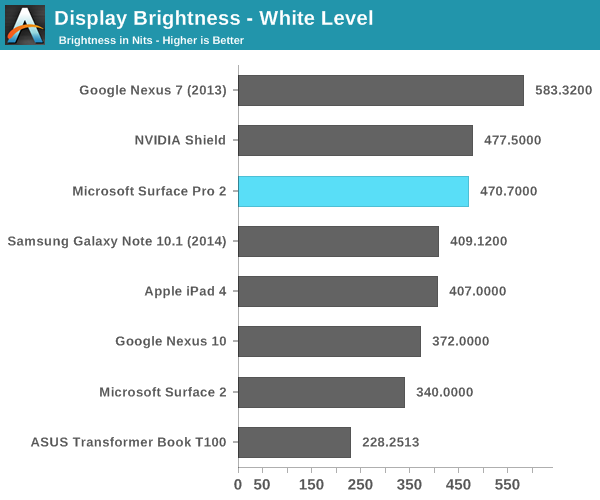
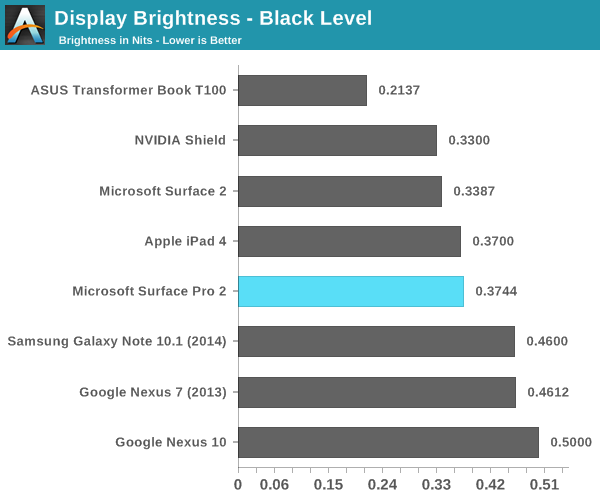
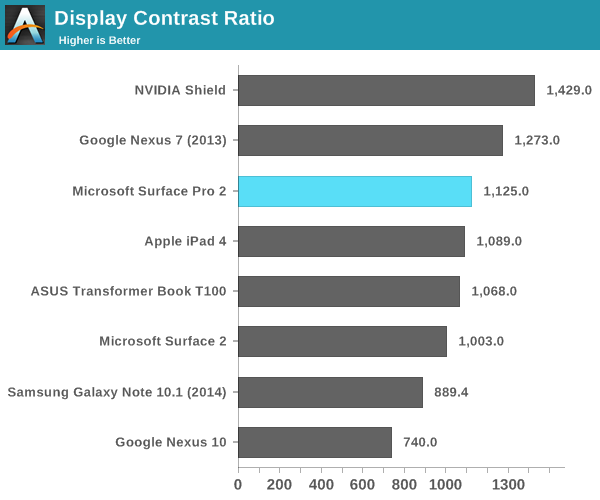
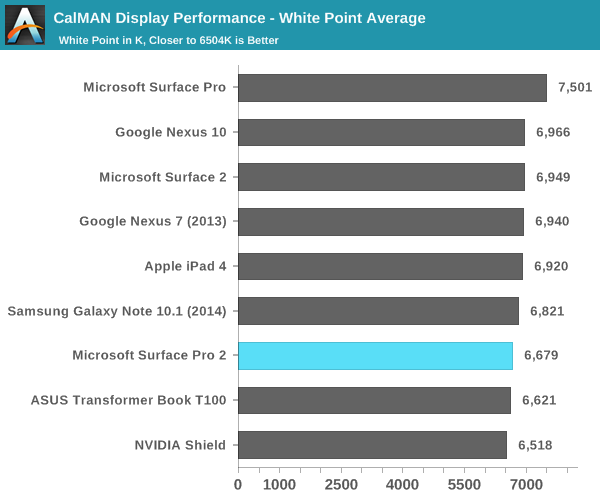
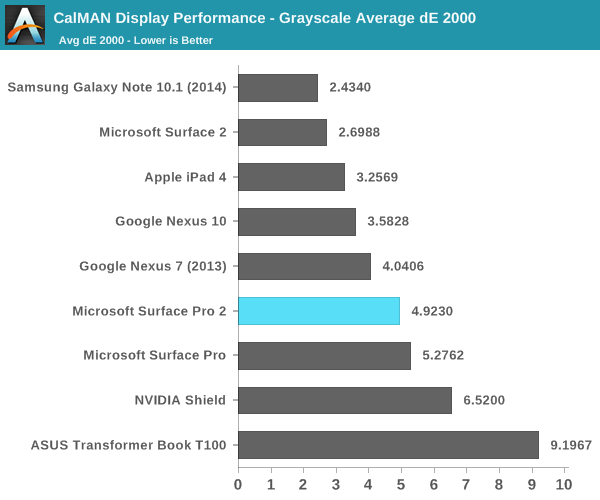
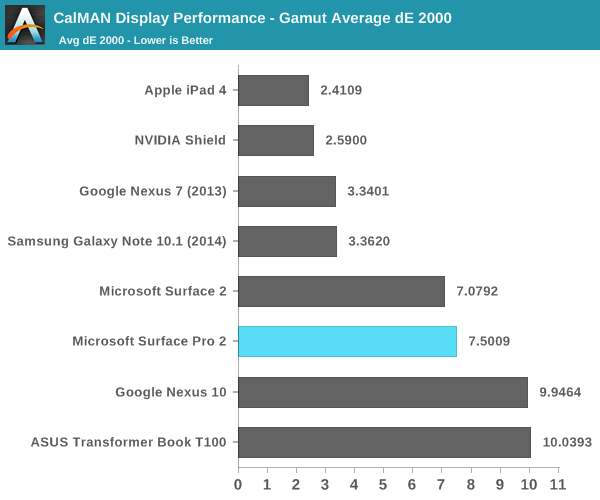



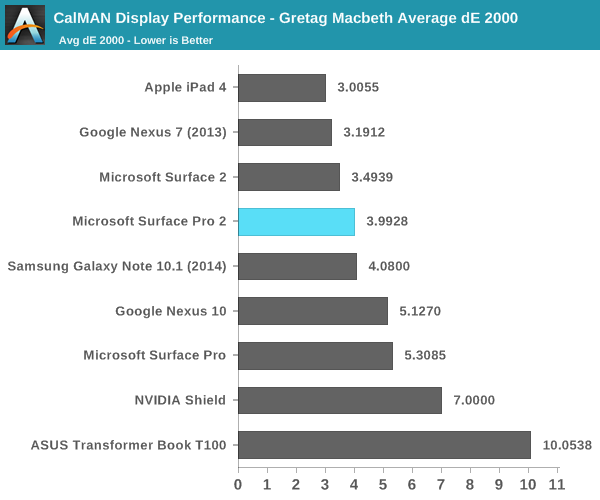

It really is a very good display, it just could be better.













277 Comments
View All Comments
chizow - Monday, October 21, 2013 - link
Exactly! Glad I wasn't the only ones to remember the chief complaints about Surface Pro. Price, size/weight, battery life. They really only addressed the last concern, battery life, and even then it's only marginally better (40%) and still FAR off from other devices that use the same Haswell ULT guts (MBA 2013).I must say Surface 2 Pro is still a disappointment. Surface 2 is much more interesting but the ARM-based Windows RT is just a non-starter for me right now. Wish it was Bay-Trail!
kyuu - Monday, October 21, 2013 - link
It's not true. Surface Pro 2 uses a different chassis than the original; it's 2 pieces instead of 3. Keeping it the same weight/thickness was a deliberate design choice, likely related to not having to redesign the thermal dissipation system, not due to reusing the old chassis.Klimax - Monday, October 21, 2013 - link
Few people. You have only assertion without any evidence, which BTW is all you can get, because poor sales can't be matched to your arbitrary terms with any analysis as there is significant problem with Surface - No World Wide distribution. Hell not even my country, bordering with Germany has it and we fall under EU, but not Irish definition of Europe...BTW: I suspect that only tiny portion of market has same lust after incredibly thin and fragile devices which you have to replace as soon as you drop it by few centimeters, because it suffered serious damage. (Note: Bit hyperbole, but point is, that thinness has severe trade offs in it self including battery and features)
chizow - Monday, October 21, 2013 - link
Right, because we don't have about a billion reasons to think the Surface underperformed last year relative to Microsoft's expectations or anything.....All I got from the Engadget review was a 3-stage kickstand instead of 2-stage, and I do believe that part is linked to just the kickstand itself. Could easily be retrofitted into the old chassis if needed.
backbydemand - Monday, October 21, 2013 - link
Apart from it is not the old chassis, it uses less parts, so is obviously not the sameschuckles - Monday, October 21, 2013 - link
i need to go with sweenish on this one...Microsoft may have over produced the previous gen surface pro/rt but that doesn't mean they are going to order 10's of thousands of a single component (chassis) without also ordering the same amount of all the other sub assemblies and building finished product. MOQ's are largely irrelevant once you go above 10k units, and microsoft already did a massive 1B $
I'm not going to speculate too much on why they didn't do a re-design and get it a few mm thinner, but i would point you to one of the positives in the review - it barely spins up the fans when lightly loaded, and that didn't cost them any time/effort to redesign the heat management on the inside...
KPOM - Monday, October 21, 2013 - link
??? Maybe they haven't changed the chassis because they are selling as many as they like and saw no need to change it. I do think we'll see a more dramatic redesign next year. It's time for the Air to go "Retina" and I think in 2014 they'll be ready to make the leap. OS X doesn't handle 150% scaling particularly well, so they are probably waiting until they can go to 200% economically.This is another reason why I think we're more likely to see iOS "grow up" into a desktop-class OS than OS X and iOS merge. OS X will still be there for enthusiasts and Pro users, but iPad will grow into a more powerful device as Apple makes the push into 64-bit.
Deepcoiler - Monday, October 21, 2013 - link
You must have missed when it what said that the chassis went from being three pieces to two. Microsoft kept the size the same, but did not reuse the old chassis.backbydemand - Monday, October 21, 2013 - link
Shhhhh, let the trolls spread their liesMadMan007 - Monday, October 21, 2013 - link
Looking over the results here and from the Asus T100 article, all I can think is what a shame it is that AMD gets virtually no design wins. I know they wouldn't be comparable to Haswell CPUs, but compared to Bay Trail Kabini is competitive in CPU performance and far better in GPU performance...the only catch would be battery life, but how will we ever know if there are absolutely no devices to compare?